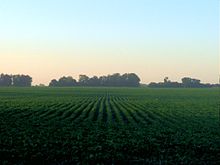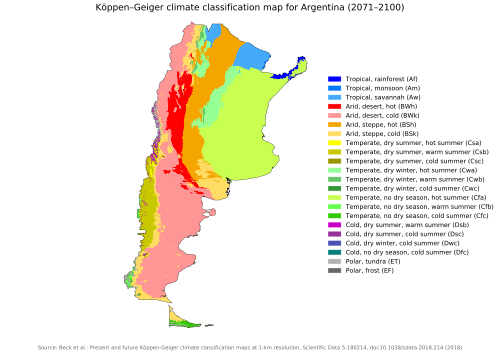Climate change in Argentina
This article's lead section may be too short to adequately summarize the key points. (December 2020) |

Climate change is predicted to have significant effects on the living conditions in
Though
Impacts on the natural environment
Temperature and weather changes

Mean temperatures have increased by 0.5 °C (0.90 °F) from 1901–2012, which is slightly lower than the global average.
Higher temperatures can reduce
The increase in minimum temperatures in much of Argentina outside Patagonia is attributed to the increase in the
Within the next 2 or 3
The following images show the projected changes in the types of climate according to the Köppen climate classification.
Precipitation and extreme weather events

There has been an increase in annual
Sea level rise
In much of the coastal regions of Argentina, it will not suffer permanent flooding and loss of land associated with
Impacts on people
Economic impacts
Agriculture

In the last half of the 20th century, the lack of snow at the highest peaks in the Cuyo region has impacted agriculture and viticulture production due to less water available in the rivers (a reduction in 50% of river flow).[7]
Numerous studies have indicated that the productivity of
Since the middle of the 20th century, the 600 mm (24 in)
Although an increase in precipitation will expand agricultural production to the west in areas that were previously too dry and will benefit
Health impacts
Climate change could extend the
Impacts on housing
Higher temperatures can negatively affect urban areas by affecting the provision of services such as water and energy by increasing the demand for these services.[3]: 94 Heat waves, such as the one in 2013–2014 during the summer could become more frequent and intense.[7] These heat waves can impact agricultural production while in urban areas, it places more demand on energy needs.[3]: 94 Intense precipitation events could become more common, leading to negative consequences.[2]: 33
Argentina, with much of its
See also
References
- ^ hdl:11336/7386. Retrieved 28 August 2015.
- ^ a b c d e f g "El Cambio Climatico en Argentina" (PDF) (in Spanish). Secretaría de Ambiente y Desarrollo Sustentable. Archived from the original (PDF) on 4 March 2016. Retrieved 20 August 2015.
- ^ a b c d e f g h i j k l m n o p q r s t u v w "Comunicación Nacional de la República Argentina a la Convención de las Naciones Unidas sobre Cambio Climatico" (PDF) (in Spanish). Secretaría de Ambiente y Desarrollo Sustentable. Archived from the original (PDF) on 4 March 2016. Retrieved 21 August 2015.
- ^ "Cómo afecta el cambio climático a la Argentina" (in Spanish). La Nacion. Archived from the original on 6 October 2015. Retrieved 21 August 2015.
- ^ a b c d e "Capitulo 2: Cambios Climáticos Observados" (PDF). Tercera Comunicación Nacional sobre Cambio Climático (in Spanish). Secretaría de Ambiente y Desarrollo Sustentable. Archived from the original (PDF) on 30 August 2015. Retrieved 27 August 2015.
- ^ a b c "Climate Overview" (PDF). Met Office. Retrieved 7 June 2015.
- ^ a b Marcelo (15 June 2014). "Cambio climático: cómo afecta ya a la Argentina" (in Spanish). Clarín. Retrieved 21 August 2015.
- PMID 11019462. Archived from the originalon 12 September 2015. Retrieved 3 September 2015.
Further reading
- Barros, Vicente; Clarke, Robin; Dias, Pedro. Climate Change in the La Plata Basin (PDF). Buenos Aires: Centro de Investigaciones del Mar y la Atmósfera. Archived from the original (PDF) on 2019-02-20.


